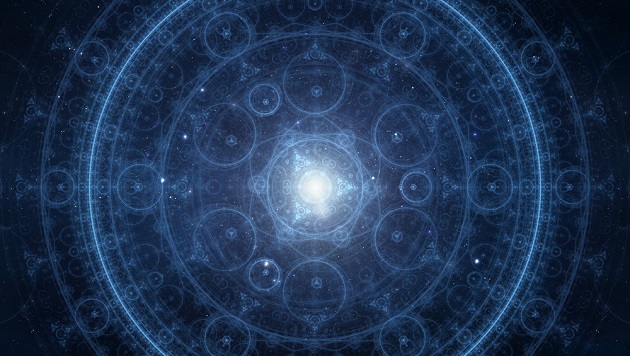“We are born at a given moment in a given place and like vintage years of wine we have the qualities of the year and of the season in which we are born. Astrology does not lay claim to anything else.” — C. G. Jung
Simply put, astrology is the study of the relationships of the objects in our solar system, relative to our viewpoint on Earth. Each object symbolizes a particular concept, or archetype, and the angles between them in the sky indicate when and how they are interacting. The sky itself is divided into twelve equal parts, providing the backdrop of this celestial drama.
Our universe is dominated by cycles, and has always been the basis for our measurement of time—from the movement of the Sun and Moon measuring days, months, and seasons to the vibrations of crystals and atoms counting out milli- and nanoseconds. The movement of the planets measure greater stretches of time; we live on an arm of a clock that tracks periods of time relevant to human life (our solar system being embedded in the even grander mechanism of the Milky Way). Every moment in history can be described by the position of the planets, and they are literally a sign of the times. You may have noticed that periods of time have a certain feeling or energy to them; these energies seem to change with the motions of the planets. However, the planets do not cause the zeitgeist any more than a clock causes time to occur. It is a correlative relationship. Cosmos and Psyche by Richard Tarnas gives a comprehensive study of the planetary cycles throughout history, both in simultaneous themes across the globe and in repetitive patterns across ages.
A basic tenet of astrology is that anything that comes into being carries the energetic signature of that moment. Your birth chart shows the planets as they were at the moment you came into the world—a cosmic time stamp—and you express those energies through your personality, your thoughts and actions. But if the position and movements of the planets are predetermined, then aren’t our lives already plotted out in advance, and aren’t we doomed to constantly fall victim to the forces of fate? This is the traditional view of astrology, and one reason why popular horoscope columns get a bad rap. It’s easy to get caught up in the idea that our interpretations have a singular, fixed meaning.
Archetypes are actually very dynamic. The Moon for example, represents the internal world of emotion and intuition, nurturing, irrationality, and The Mother, to name a few. When the Moon archetype is activated in a person, any or all of these themes can be present and manifesting in a myriad of ways, while still operating within the lunar archetype. When we consider that this is happening with each planet, and their periodic interactions, we begin to see a complexity on par with the lives that we live.
This multivalent nature of archetypes is why two people can have different subjective experiences of the same objective event, or why two people born at the same time can have different personalities and life courses (while being archetypally identical). And besides the multiplicity of manifestation within an archetype, its multidimensional nature means that it can occur on any level of perception: personal (thoughts and feelings), social (interpersonal encounters and interactions), or global (large scale events). Nevertheless, even though each person’s experience and reaction to the energies of any given time may be unique, they will be recognizable and congruent with the archetypes involved.
The modern understanding of astrology rests on the theories of synchronicity and archetypes, both extensively studied and formulated by psychologist Carl Jung. Synchronicity is the phenomenon of meaningful coincidence. Often it is an objective/external event coinciding with a subjective/internal state of being. It is up to the individual to recognize, interpret, and assign significance to the synchronicity (however, this is not merely an intrapsychic projective phenomenon, as we will see). Archetypes, as we have been discussing, are the fundamental forms of consciousness; the perennial themes of philosophy, psychology, and art. If there is something that impassions or moves us, it has an archetypal nature. They permeate and transcend human culture. Though we often think of archetypes as the immutable forms that define humanity, they are truly universal themes. They are interwoven with the natural world. Birth, death, struggle, cooperation, growth…these are not human constructs, but we are in a unique position to observe and embody them.
In Cosmos and Psyche, Richard Tarnas describes the modern worldview. During the “Age of Enlightenment,” Western thought moved further away from the aboriginal view of being embedded in a sentient universe, with intelligent spirit(s) permeating all of nature. Instead, we began to become more conscious of our ability to determine our own destiny and to predict and harness nature to our own purpose. Consequently, more and more meaning and subjectivity was attributed to the human mind, with less significance and purpose to the natural world, increasingly objectifying it. Humanity has launched itself forward with leaps in areas such as science, art, and philosophy. But we find ourselves increasingly isolated in a random, mechanistic, and meaningless universe. A “disenchanted cosmos,” as Tarnas puts it.
If we are to recognize the universe as an intelligence with which we can interact, as Tarnas suggests, then we can consider archetypes as the language of the cosmos, and synchronicity as the mode of communication. Astrology is an incredibly rich study and practice of this kind of conversation. Each planet represents an archetypal character, and their positions relative to the Earth and to each other weaves a complex outline of an unmistakably human drama. Again, these dynamics are reflected to varying degrees at every level of our lives: from our individual moods, impulses, and actions, to the people and situations we encounter, to the collective social and political currents we are immersed in.
If we perceive the language of archetypes, and the communication of synchronicity, then we will likely also perceive an intelligent Source. We may call this God, anima mundi, the fertile void, or nothing at all, but a cosmic consciousness seems to persist nonetheless. As we interact with synchronicity, observing the rippling consequences that our interpretations have, coincidence becomes opportunity, and dialogue is born. We begin to see the nature of this consciousness we are interacting with.
Empathy is a process that allows an individual to recognize the subjectivity of another. Our own perspective diminishes enough to let in another. We understand how they feel in their circumstance, and why. And compassion develops because we recognize a part of ourselves in that other (or is it a part of them in us?), despite the apparent dissimilarities. We recognize that others are not merely objects existing in our reality, but that we are interdependent subjects in a shared reality. Empathy develops through the sharing of experience, emotion, and vulnerability. It is risky because this kind of interaction threatens to dispel currently (and perhaps dearly) held beliefs, but it is also a natural phenomenon within personal and social development. It is the only process that can overcome the fear and prejudice running rampant through our global community.
I believe that astrology is one way that we can cultivate empathy for the universe we live in. Our world is desperate for a new perspective. The Earth and its non-human inhabitants cannot afford to continue to be objectified, commodified, and disregarded. We must imbue the things we dehumanize with inherent value, purpose, and wisdom, learning from the things we thought to dismiss. In this way we can re-enchant the cosmos, and find ourselves embedded in a universe more beautiful and sustaining than we otherwise could have imagined.
In Part 2 of this article we will explore the therapeutic implications of astrology for personal healing and growth.








Reblogged this on Lost Dudeist Astrology.
Detailed information 👍